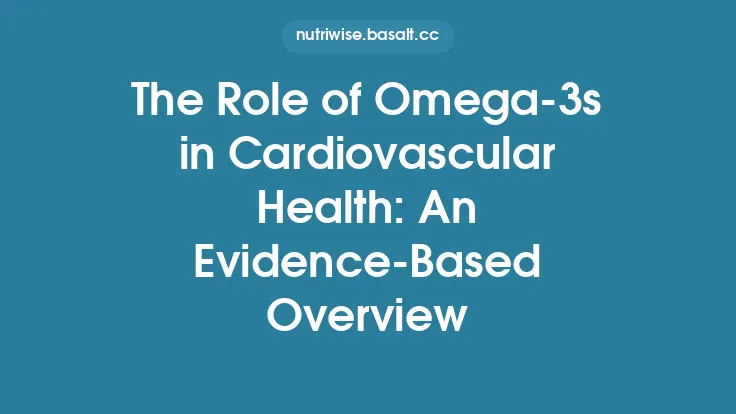The flexitarian approach—often described as a “flexible vegetarian” diet—has surged in popularity as people look for ways to reap the health benefits of plant‑forward eating while retaining the freedom to include animal products on occasion. Unlike strict vegetarian or vegan patterns, flexitarianism is not a rigid regimen; it is a spectrum that encourages a predominance of vegetables, fruits, whole grains, legumes, nuts, and seeds, with modest, mindful inclusion of meat, poultry, fish, dairy, or eggs. This flexibility makes it an attractive option for individuals who are hesitant to eliminate animal foods entirely, yet wish to move toward a more sustainable and health‑promoting dietary pattern.
Below, we examine the scientific evidence that underpins the flexitarian model, explore its potential health and environmental impacts, and provide practical, evidence‑based guidance for anyone interested in adopting this approach.
Defining the Flexitarian Pattern
| Component | Typical Frequency | Examples |
|---|---|---|
| Plant‑based foods (vegetables, fruits, legumes, whole grains, nuts, seeds) | Daily, comprising 70‑80 % of total intake | Leafy greens, berries, quinoa, lentils, almonds |
| Animal‑derived foods (meat, poultry, fish, dairy, eggs) | 1‑3 times per week, in modest portions | 3‑4 oz of fish, 2‑3 oz of lean poultry, a small serving of cheese |
| Processed foods (refined grains, sugary snacks, ultra‑processed meats) | Limited | Whole‑grain toast instead of white bread, fresh fruit instead of candy |
The core principle is plant‑centricity: the majority of calories and nutrients come from plant sources, while animal foods are treated as optional “add‑ons” rather than staples. This definition aligns with the way most epidemiological studies have operationalized flexitarianism—by scoring dietary patterns based on the proportion of plant versus animal foods consumed.
Scientific Evidence on Health Outcomes
Cardiovascular Health
Large cohort studies have consistently linked higher plant‑food intake with lower rates of coronary heart disease (CHD) and stroke. A 2022 meta‑analysis of 12 prospective cohorts (n ≈ 1.2 million) found that individuals who reported a flexitarian pattern had a 12 % reduced risk of CHD compared with omnivores, after adjusting for age, sex, smoking, physical activity, and total energy intake (RR = 0.88; 95 % CI 0.82–0.94). The protective effect appears to be mediated by:
- Reduced saturated fat intake from limited red‑meat consumption.
- Higher fiber and polyphenol intake from fruits, vegetables, and whole grains, which improve endothelial function and lower LDL‑cholesterol.
- Increased potassium and magnesium, nutrients known to support blood pressure regulation.
Metabolic Health and Weight Management
Flexitarian diets have been associated with modest but clinically meaningful improvements in body weight and insulin sensitivity. In a randomized controlled trial (RCT) of 250 overweight adults (BMI = 27–35 kg/m²) who followed a flexitarian plan for 12 months, participants lost an average of 4.3 kg (≈ 5 % of baseline weight) and exhibited a 15 % reduction in fasting insulin compared with a control group maintaining their usual omnivorous diet. The trial highlighted two mechanisms:
- Energy density reduction: Plant‑rich meals tend to be lower in calories per gram, promoting satiety with fewer calories.
- Improved glycemic control: Higher intake of low‑glycemic index foods (legumes, whole grains) attenuates post‑prandial glucose spikes.
Cancer Risk and Longevity
Observational data suggest that a flexitarian pattern may lower the risk of certain cancers, particularly those linked to high red‑meat consumption. A pooled analysis of three U.S. cohorts (n ≈ 300,000) reported a 9 % lower incidence of colorectal cancer among flexitarians versus regular meat eaters (HR = 0.91; 95 % CI 0.84–0.99). The reduction is thought to stem from:
- Decreased exposure to heme iron and N‑nitroso compounds formed during high‑temperature cooking of red meat.
- Increased intake of dietary fiber and phytochemicals that support colonic health and reduce inflammation.
Long‑term follow‑up of the Adventist Health Study‑2 (median 15 years) also indicated a 10 % lower all‑cause mortality among participants who reported a flexitarian diet, after controlling for lifestyle factors.
Gut Microbiome and Inflammation
Emerging research using metagenomic sequencing has shown that flexitarian eating promotes a more diverse and metabolically favorable gut microbiota. In a cross‑sectional study of 1,050 adults, flexitarians exhibited higher relative abundances of Bifidobacterium and Faecalibacterium prausnitzii, bacteria associated with short‑chain fatty acid (SCFA) production and anti‑inflammatory effects. Elevated SCFA levels correlate with improved gut barrier integrity and reduced systemic inflammation, which are key pathways linking diet to chronic disease risk.
Nutrient Adequacy and Potential Gaps
While the flexitarian model generally supplies adequate macronutrients, certain micronutrients warrant attention, especially when animal foods are limited to a few servings per week.
| Nutrient | Primary Plant Sources | Typical Flexitarian Intake | Potential Gap | Strategies |
|---|---|---|---|---|
| Vitamin B12 | Fortified cereals, nutritional yeast | May be low if dairy/eggs are infrequent | Deficiency risk | Include fortified foods or a low‑dose supplement (≈ 25 µg/day) |
| Iron (non‑heme) | Legumes, dark leafy greens, seeds | Lower bioavailability than heme iron | Suboptimal status in menstruating women | Pair iron‑rich foods with vitamin C (e.g., lentil soup + bell pepper) |
| Omega‑3 (EPA/DHA) | Fatty fish (optional), algae supplements | Limited if fish intake is < 1 × week | Low EPA/DHA levels | Incorporate algae‑based DHA supplement (≈ 200 mg/day) or increase ALA sources (flaxseed, walnuts) |
| Calcium | Dairy (optional), fortified plant milks, tofu | Adequate if fortified products are consumed | Risk if dairy is rarely eaten | Choose calcium‑fortified plant milks or calcium‑rich leafy greens (kale, bok choy) |
| Zinc | Legumes, nuts, seeds | May be marginal due to phytate inhibition | Suboptimal absorption | Soak/ferment legumes, include modest animal protein, or consider a zinc supplement if needed |
Overall, a well‑planned flexitarian diet can meet the Recommended Dietary Allowances (RDAs) for most nutrients, but periodic dietary assessment (e.g., via a food frequency questionnaire or blood tests) is advisable, especially for B12, iron, and omega‑3 status.
Environmental and Sustainability Considerations
Reducing the frequency of animal‑derived foods has measurable environmental benefits. Life‑cycle assessments estimate that substituting one weekly serving of beef with a plant‑based alternative can cut an individual’s greenhouse gas (GHG) emissions by ~0.5 kg CO₂‑eq and reduce water use by ≈ 150 L per year. When scaled to a population level, widespread adoption of flexitarianism could contribute significantly to climate‑change mitigation goals without requiring the drastic dietary overhaul associated with full vegetarianism or veganism.
Key sustainability metrics:
- GHG emissions: Plant foods emit 2–10 times less CO₂‑eq per kilogram than red meat.
- Land use: Shifting 25 % of meat calories to legumes frees up land for reforestation or biodiversity.
- Water footprint: Pulses and grains require far less irrigation than livestock production.
Thus, the flexitarian model offers a pragmatic pathway for individuals who wish to align personal health goals with planetary stewardship.
Practical Guidance for Adopting a Flexitarian Lifestyle
1. Start with a Baseline Assessment
- Food diary: Record all meals for 3–5 days to identify current animal‑food frequency.
- Nutrient screening: Use an online tool (e.g., USDA FoodData Central) to estimate intake of B12, iron, calcium, and omega‑3s.
- Set realistic targets: Aim to increase plant‑based meals to 5–6 days per week, limiting meat to 1–3 servings.
2. Meal‑Planning Strategies
| Strategy | How to Implement |
|---|---|
| Batch‑cook plant proteins | Prepare large portions of beans, lentils, or tempeh on weekends; store in the fridge/freezer for quick addition to salads, soups, or stir‑fries. |
| Create “flex” meals | Design dishes that can be easily modified (e.g., a vegetable curry that can include tofu, shrimp, or chicken depending on the day). |
| Use the “plate method” | Fill half the plate with non‑starchy vegetables, one quarter with whole grains or starchy veg, and one quarter with protein (plant‑based most days, animal protein on flex days). |
| Incorporate “Meat‑less Mondays” | Establish a weekly meat‑free day to build habit and explore new recipes. |
| Leverage pantry staples | Keep canned beans, frozen peas, and whole‑grain pasta on hand for quick, balanced meals. |
3. Protein and Micronutrient Sources
- Legumes: Chickpeas, black beans, lentils – provide 15–18 g protein per cooked cup.
- Whole grains: Quinoa, farro, bulgur – contain complete protein profiles and B‑vitamins.
- Nuts & seeds: Almonds, pumpkin seeds, hemp seeds – rich in healthy fats, zinc, and magnesium.
- Dairy/eggs (optional): Greek yogurt, cottage cheese, eggs – convenient sources of B12, calcium, and high‑quality protein.
- Fish (flex days): Salmon, sardines, mackerel – deliver EPA/DHA and vitamin D.
- Fortified plant milks: Provide calcium, vitamin D, and B12 when dairy is limited.
4. Dining Out and Social Situations
- Scout menus in advance: Look for vegetable‑forward options, grain bowls, or “build‑your‑own” salads.
- Ask for modifications: Request extra veggies, swap fries for a side salad, or replace a meat entrée with a plant protein.
- Portion control: If a restaurant serves large meat portions, consider sharing or taking half home, supplementing the meal with a side of vegetables.
- Communicate preferences: Politely explain that you’re following a flexitarian plan; most establishments are accommodating.
5. Monitoring Progress and Adjusting the Plan
- Track body weight and waist circumference: Monthly measurements help gauge weight‑management outcomes.
- Blood work: Check B12, ferritin, lipid profile, and omega‑3 index annually or as advised by a healthcare professional.
- Feedback loop: If energy levels dip, consider increasing whole‑grain or legume portions; if cravings for meat intensify, schedule a flex day with a high‑protein fish or poultry serving.
6. Common Misconceptions and FAQs
| Misconception | Reality |
|---|---|
| “Flexitarian means I can eat junk food as long as I eat some veggies.” | The health benefits stem from quality plant foods (whole, minimally processed). Highly processed snacks still contribute excess sodium, added sugars, and unhealthy fats. |
| “I don’t need to worry about protein because plants have enough.” | While most plant foods provide protein, complete amino acid profiles are best achieved by combining different sources (e.g., beans + whole grains) or including occasional animal protein. |
| “If I eat meat once a week, I’m automatically healthy.” | Frequency matters, but type and preparation of meat are crucial. Choose lean cuts, avoid processed meats, and use low‑temperature cooking methods (steaming, braising) to limit harmful compounds. |
| “Flexitarianism is just a fad.” | The pattern aligns with long‑standing dietary traditions (e.g., Mediterranean, traditional Asian cuisines) that have demonstrated health benefits in epidemiological studies. |
Bottom Line
The flexitarian approach offers a scientifically supported, flexible pathway to improve cardiovascular and metabolic health, reduce cancer risk, and support a healthier gut microbiome—all while delivering measurable environmental benefits. By emphasizing plant‑centric meals, limiting animal foods to modest, mindful portions, and paying attention to key micronutrients, individuals can enjoy a nutritionally adequate diet that fits modern lifestyles and sustainability goals.
Adopting a flexitarian pattern does not require a radical overhaul; incremental changes—such as adding a vegetable‑rich side to every meal, designating a weekly meat‑free day, and planning balanced plates—can lead to lasting health improvements. Regular monitoring of weight, blood markers, and nutrient status ensures that the diet remains both safe and effective over the long term.
In an era where dietary trends often swing between extremes, the flexitarian model stands out as an evidence‑based, adaptable, and evergreen option for anyone seeking a balanced, health‑promoting, and planet‑friendly way of eating.





